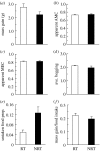The adaptive value of parental responsiveness to nestling begging
- PMID: 17650473
- PMCID: PMC2274972
- DOI: 10.1098/rspb.2007.0658
The adaptive value of parental responsiveness to nestling begging
Abstract
Despite extensive theoretical and empirical research into offspring food solicitation behaviour as a model for parent-offspring conflict and communication, the adaptive value of parental responsiveness to begging has never been tested experimentally. Game theory models, as well as empirical studies, suggest that begging conveys information on offspring state, which implies that parental investment can be better translated to fitness by responding to begging when allocating resources rather than by ignoring it. However, this assumption and its underlying mechanisms have received little or no attention. Here we show by experiments with hand-raised house sparrow (Passer domesticus) nestlings that a 'responsive parent' will do better than a hypothetical 'non-responsive' mutant (that provides similar food amounts, but irrespective of begging). This is neither because food-deprived nestlings convert food to mass more efficiently, however, nor because responsiveness reduces costly begging. Rather, responsiveness to begging is adaptive because it reduces two opposing risks: one is wasting time when returning too soon to feed already satiated nestlings and the other is repeatedly overlooking some nestlings as a result of the stochastic nature of a random, non-responsive strategy. This study provides the first experimental evidence for the adaptive value of parental responsiveness to offspring begging.
Figures




Similar articles
-
An immunological cost of begging in house sparrow nestlings.Proc Biol Sci. 2010 Jul 7;277(1690):2083-8. doi: 10.1098/rspb.2010.0109. Epub 2010 Mar 10. Proc Biol Sci. 2010. PMID: 20219741 Free PMC article.
-
Heritability of nestling begging intensity in the house sparrow (Passer domesticus).Evolution. 2009 Mar;63(3):738-48. doi: 10.1111/j.1558-5646.2008.00598.x. Epub 2009 Jan 2. Evolution. 2009. PMID: 19210530
-
Effects of experimental increase of corticosterone levels on begging behavior, immunity and parental provisioning rate in house sparrows.Gen Comp Endocrinol. 2008 Jan 1;155(1):101-8. doi: 10.1016/j.ygcen.2007.03.004. Epub 2007 Mar 18. Gen Comp Endocrinol. 2008. PMID: 17448473
-
Begging and bleating: the evolution of parent-offspring signalling.Philos Trans R Soc Lond B Biol Sci. 2000 Nov 29;355(1403):1581-91. doi: 10.1098/rstb.2000.0719. Philos Trans R Soc Lond B Biol Sci. 2000. PMID: 11127903 Free PMC article. Review.
-
Parent-offspring conflict and co-adaptation: behavioural ecology meets quantitative genetics.Proc Biol Sci. 2008 Aug 22;275(1645):1823-30. doi: 10.1098/rspb.2008.0199. Proc Biol Sci. 2008. PMID: 18460430 Free PMC article. Review.
Cited by
-
Passerine birds breeding under chronic noise experience reduced fitness.PLoS One. 2012;7(7):e39200. doi: 10.1371/journal.pone.0039200. Epub 2012 Jul 11. PLoS One. 2012. PMID: 22808028 Free PMC article.
-
Fledgling Sex Ratio Is Determined by Egg Loss, Hatching Order, Nestling Mortality, and Inter-Annual Food Fluctuations for Boreal Owls, Aegolius funereus.Ecol Evol. 2025 Mar 13;15(3):e71001. doi: 10.1002/ece3.71001. eCollection 2025 Mar. Ecol Evol. 2025. PMID: 40092900 Free PMC article.
-
Female birds monitor the activity of their mates while brooding nest-bound young.Anim Cogn. 2021 May;24(3):613-628. doi: 10.1007/s10071-020-01453-5. Epub 2021 Jan 3. Anim Cogn. 2021. PMID: 33392914 Free PMC article.
-
Sense and sensitivity: responsiveness to offspring signals varies with the parents' potential to breed again.Proc Biol Sci. 2011 Sep 7;278(1718):2638-45. doi: 10.1098/rspb.2010.2594. Epub 2011 Jan 26. Proc Biol Sci. 2011. PMID: 21270035 Free PMC article.
-
Condition-Dependent Begging Elicits Increased Parental Investment in a Wild Bird Population.Am Nat. 2019 May;193(5):725-737. doi: 10.1086/702848. Epub 2019 Mar 14. Am Nat. 2019. PMID: 31002567 Free PMC article.
References
-
- Afik D, Karasov W.H. The trade-offs between digestion rate and efficiency in warblers and their ecological implications. Ecology. 1995;76:2247–2257. doi:10.2307/1941699 - DOI
-
- Bengtsson H, Rydén O. Parental feeding rate in relation to begging behavior in asynchronously hatched broods of the great tit Parus major—an experimental-study. Behav. Ecol. Sociobiol. 1983;12:243–251. doi:10.1007/BF00290777 - DOI
-
- Biran, I. 2004 Nestling begging strategies and learning rules in virtual nests: a computer simulation study. MSc thesis, Tel-Aviv University, Israel.
-
- Budden A.E, Wright J. In: Begging in nestling birds. Current ornithology. Nolan V, Ketterson E, editors. vol. 16. Kluwer Academic/Plenum; New York, NY: 2001. pp. 83–118.
-
- Burford J.E, Friedrich T.J, Yasukawa K. Response to playback of nestling begging in the red-winged blackbird Agelaius phoeniceus. Anim. Behav. 1998;56:555–561. doi:10.1006/anbe.1998.0830 - DOI - PubMed
Publication types
MeSH terms
LinkOut - more resources
Full Text Sources

